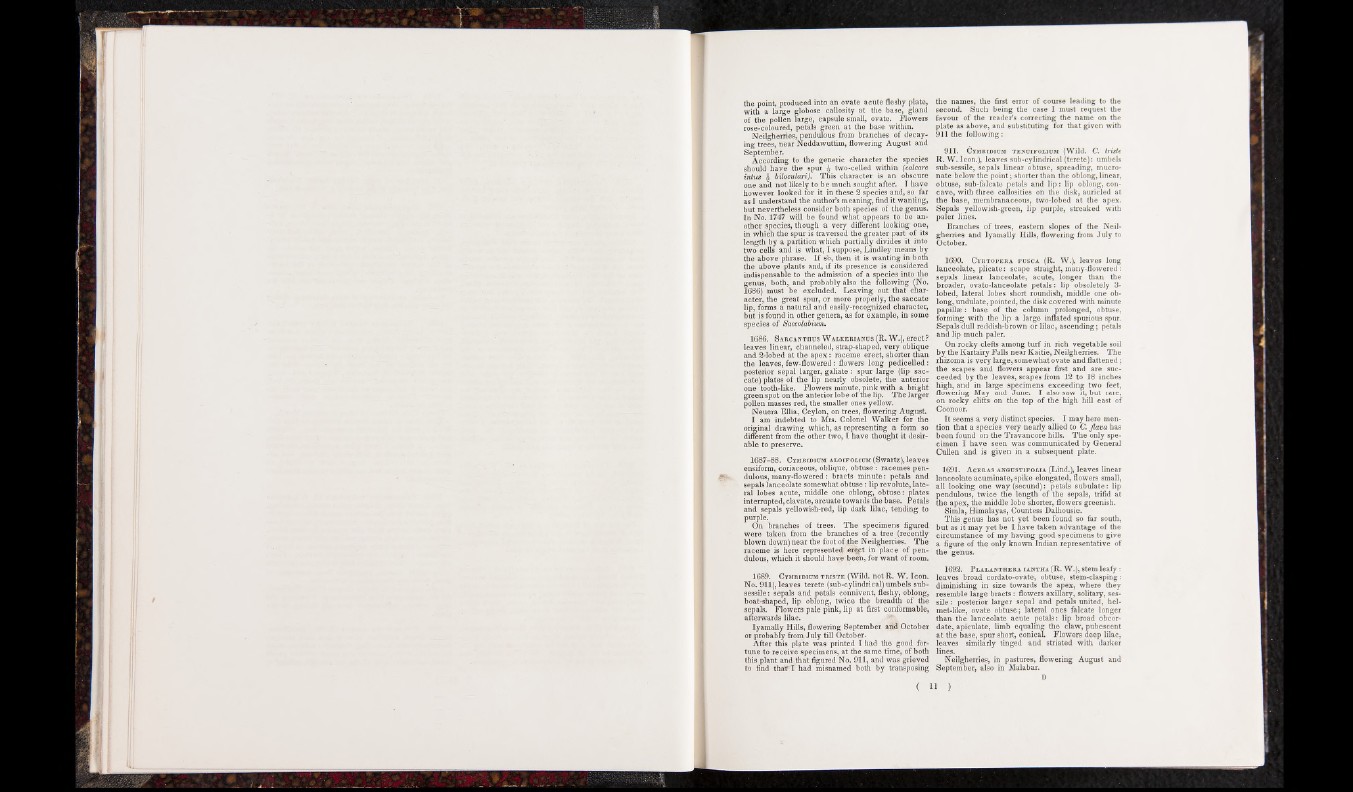
the point, produced into an ovate acute fleshy plate,
with a large globose callosity at the base, gland
of the pollen large, capsule small, ovate. Flowers
rose-coloured, petals green at the base within.
Neilgherries, pendulous from branches of decaying
trees, near Neddawuttim, flowering August and
September.
According to the generic character the species
should have the spur ^ two-celled within (calcare
intus £ biloculari). This character is an obscure
one and not likely to be much sought after1. I have
however looked for it in these 2 species and, so far
as I understand the author’s meaning, find it wanting,
but nevertheless consider both species of the genus.
In No. 1747 will be found what appears to be another
species, though a very different looking one,
in which the spur is traversed the greater part of its
length by a partition which partially divides it into
two cells and is what, I suppose, Lindley means by
the above phrase. If s*o, then it is wanting in both
the above plants and, if its presence is considered
indispensable to the admission of a species into the
genus, both, and probably also the following (No.
1686) must be excluded. Leaving out that character,
the great spur, or more properly, the saccate
lip, forms a natural and easily-recognized character,
but is found in other genera, as for example, in some
species of Saccolabium.
1686. Sarcanthus Walkerianus (R. W.), erect?
leaves linear, channeled, strap-shaped, very oblique
and 2-lobed at the apex: raceme erect, shorter than
the leaves, few-flowered: flowers long pedicelled:
posterior sepal larger, galiate: spur large (lip saccate)
plates of .the lip nearly obsolete, the anterior
one tooth-like. Flowers minute, pink with a bright
green spot on the anterior lobe of the lip. The larger
pollen masses red, the smaller ones yellow.
Neuera Ellia, Ceylon, on trees, flowering August.
I am indebted to Mrs. Colonel Walker for the
original drawing which, as representing a form so
different from the other two, I have thought it desirable
to preserve.
1687-88. Cymbidium aloifolium (Swartz), leaves
ensiform, coriaceous, oblique, obtuse: racemes pendulous,
many-flowered: bracts minute: petals and
sepals lanceolate somewhat obtuse: lip revolute, lateral
lobes acute, middle one oblong, obtuse: plates
interrupted, clavate, arcuate towards the base. Petals
and sepals yellowish-red, lip dark lilac, tending to
purple.
On branches of trees. The specimens figured
were taken from the branches of a tree (recently
blown down) near the foot of-^he Neilgherries. The
raceme is here represented, er§ct in place of pendulous,
which it should have been, for w ant of room.
1689. Cymbidium triste (Wild, not R. W. Icon.
No. 911), leaves terete (sub-cylindrical) umbels sub-
sessile : sepals and petals connivent, fleshy, oblong,
boat-shaped, lip oblong, twice the breadth of the
sepals. Flowers pale pink, lip at first conformable,
afterwards lilac.
Iyamally Hills, flowering September arid October
or probably from July till October.
After this plate was printed I had the good fortune
to receive specimens, at the same time, of both
this plant and that figured No. 911, and was grieved
to find thacffl had misnamed both by transposing
the names, the first error of course leading to the
second. Such being the case I must request the
favour of the reader’s correcting the name on the
plate as above, and substituting for that given with
911 the following:
911. Cymbidium tenuifolium (Wild. C. triste
R. W . Icon.), leaves sub-cylindrical (terete): umbels
sub-sessile, sepals linear obtuse, spreading, mucro-
nate below the point; shorter than the oblong, linear,
obtuse, sub-falcate petals and lip : lip oblong, concave,
with three callosities on the disk, auricled at
the base, membranaceous, two-lobed at the apex.
Sepals yellowish-green, lip purple, streaked with
paler lines.
Branches of trees, eastern slopes of the Neilgherries
and Iyamally Hills, flowering from July to
October.
1690. Cyrtopera fusca (R. W.), leaves long
lanceolate, plicate: scape straight, many-flowered :
sepals linear lanceolate, acute, longer than the
broader, ovato-lanceolate petals: lip obsoletely 3-
lobed, lateral lobes short roundish, middle one oblong,
undulate, pointed, the disk covered with minute
papillae: base of the column prolonged, obtuse,
forming with the lip a large inflated spurious spur.
Sepals dull reddish-brown or lilac, ascending; petals
and lip much paler.
On rocky clefts among turf in rich vegetable soil
by the Kartairy Falls near Kaitie, Neilgherries. The
rnizoma is very large, somewhat ovate and flattened;
the scapes and flowers appear first and are succeeded
by the leaves, scapes from 12 to 18 inches
high, and in large specimens exceeding two feet,
flowering May and June. I also saw it, but rare,
on rocky clifts on the top of the high hill east of
Coonoor.
It seems a very distinct species. I may here mention
that a species very nearly allied to C. f la w has
been found on the Travancore hills. The only specimen
I have seen was communicated by General
Cullen and is given in a subsequent plate.
1691. Ac.eras angustifoxjIa (Lind.), leaves linear
lanceolate acuminate, spike elongated, flowers small,
all looking one way (secund): petals subulate: lip
pendulous, twice the length of the sepals, trifid at
the apex, the middle lobe shorter, flowers greenish.
Simla, Himalayas, Countess Dalhousie.
This genus has not yet been found so far south,
but as it may yet be I nave taken advantage of the
circumstance of my having good specimens to give
a figure of the only known Indian representative of
the genus.
1692. Plalanthera iantha (R. W.), stem leafy:
leaves broad cordato-ovate, obtuse, stem-clasping:
diminishing in size towards the apex, where they
resemble large bracts: flowers axillary, solitary, sessile
: posterior larger sepal and petals united, helmet
like, ovate obtuse; lateral ones falcate longer
than the lanceolate acute petals: lip broad obcor-
date, apiculate, limb equaling the claw, pubescent
at the base, spur short, conical Flowers deep lilac,
leaves similarly tinged and striated with darker
lines.
Neilgherries, in pastures, flowering August and
September, also in Malabar.
D
( n )